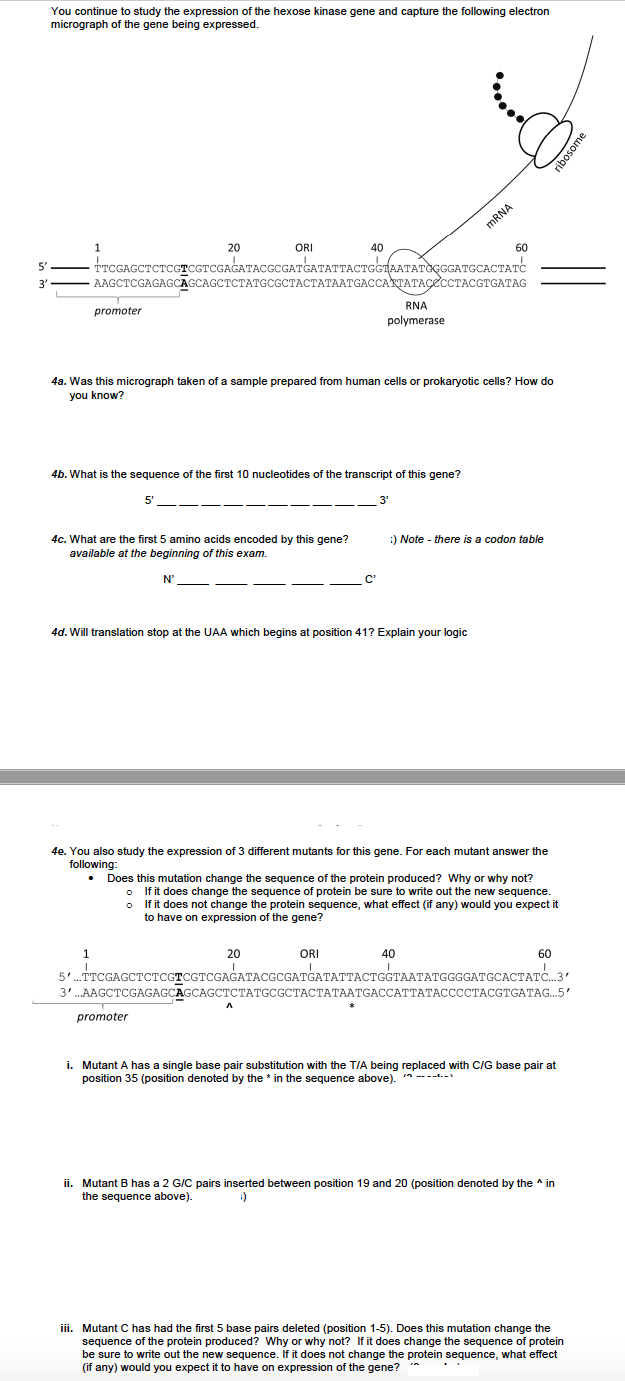MRNA 20 ORI 40 - FTCGAGCTCTCGTCGTCGAGATACGCGATGATATTACTGGHAATATOGGGATGCACTATC AAGCTCGAGAGCAGCAGCTCTATGCGCTACTATAATGACCANTATACECCTACGTGATAG 60 promoter RNA polymerase 4a. Was this micrograph taken of a sample prepared from human cells or prokaryotic cells? How do you know? 4b. What is the sequence of the first 10 nucleotides of the transcript of this gene? 3' 4c. What are the first 5 amino acids encoded by this gene? available at the beginning of this exam. ) Note - there is a codon table N'. 4d. Will translation stop at the UAA which begins at position 41? Explain your logic ribosome
MRNA 20 ORI 40 - FTCGAGCTCTCGTCGTCGAGATACGCGATGATATTACTGGHAATATOGGGATGCACTATC AAGCTCGAGAGCAGCAGCTCTATGCGCTACTATAATGACCANTATACECCTACGTGATAG 60 promoter RNA polymerase 4a. Was this micrograph taken of a sample prepared from human cells or prokaryotic cells? How do you know? 4b. What is the sequence of the first 10 nucleotides of the transcript of this gene? 3' 4c. What are the first 5 amino acids encoded by this gene? available at the beginning of this exam. ) Note - there is a codon table N'. 4d. Will translation stop at the UAA which begins at position 41? Explain your logic ribosome
Human Heredity: Principles and Issues (MindTap Course List)
11th Edition
ISBN:9781305251052
Author:Michael Cummings
Publisher:Michael Cummings
Chapter15: Genomes And Genomics
Section: Chapter Questions
Problem 13QP
Related questions
Concept explainers
Gene Interactions
When the expression of a single trait is influenced by two or more different non-allelic genes, it is termed as genetic interaction. According to Mendel's law of inheritance, each gene functions in its own way and does not depend on the function of another gene, i.e., a single gene controls each of seven characteristics considered, but the complex contribution of many different genes determine many traits of an organism.
Gene Expression
Gene expression is a process by which the instructions present in deoxyribonucleic acid (DNA) are converted into useful molecules such as proteins, and functional messenger ribonucleic (mRNA) molecules in the case of non-protein-coding genes.
Topic Video
Question

Transcribed Image Text:You continue to study the expression of the hexose kinase gene and capture the following electron
micrograph of the gene being expressed.
MRNA
1
20
ORI
40
60
TTCGAGCTCTCGTCGTCGAGATACGCGATGATATTACTGGTAATATGGGGATGCACTATC
AAGCTCGAGAGCAСCAGCTСТАТGCGСТАСТАТААТGAССАКТАТАСССТАCGTGATAG
5"
3'
RNA
promoter
polymerase
4a. Was this micrograph taken of a sample prepared from human cells or prokaryotic cells? How do
you know?
4b. What is the sequence of the first 10 nucleotides of the transcript of this gene?
5'
3'
---
4c. What are the first 5 amino acids encoded by this gene?
)Note - there is a codon table
available at the beginning of this exam.
N'
C'
4d. Will translation stop at the UAA which begins at position 41? Explain your logic
4e. You also study the expression of 3 different mutants for this gene. For each mutant answer the
following:
Does this mutation change the sequence of the protein produced? Why or why not?
If it does change the sequence of protein be sure to write out the new sequence.
o If it does not change the protein sequence, what effect (if any) would you expect it
to have on expression of the gene?
1
20
ORI
40
60
5'.TTCGAGCTCTCGTCGTCGAGATACGCGATGATATTACTGGTAATATGGGGATGCACTAT.3'
3'...АAGCTCGAGAGCAGCAGCTCТАТСCGCTАСТАТААTGACCATTAТАССССТАСGTGATAG..5'
promoter
i. Mutant A has a single base pair substitution with the TIA being replaced with C/G base pair at
position 35 (position denoted by the * in the sequence above).
ii. Mutant B has a 2 GIC pairs inserted between position 19 and 20 (position denoted by the ^ in
the sequence above).
ii. Mutant C has had the first 5 base pairs deleted (position 1-5). Does this mutation change the
sequence of the protein produced? Why or why not? If it does change the sequence of protein
be sure to write out the new sequence. If it does not change the protein sequence, what effect
(if any) would you expect it to have on expression of the gene?
ribosome
Expert Solution
This question has been solved!
Explore an expertly crafted, step-by-step solution for a thorough understanding of key concepts.
Step by step
Solved in 2 steps with 1 images

Knowledge Booster
Learn more about
Need a deep-dive on the concept behind this application? Look no further. Learn more about this topic, biology and related others by exploring similar questions and additional content below.Recommended textbooks for you

Human Heredity: Principles and Issues (MindTap Co…
Biology
ISBN:
9781305251052
Author:
Michael Cummings
Publisher:
Cengage Learning

Biology (MindTap Course List)
Biology
ISBN:
9781337392938
Author:
Eldra Solomon, Charles Martin, Diana W. Martin, Linda R. Berg
Publisher:
Cengage Learning

Biochemistry
Biochemistry
ISBN:
9781305577206
Author:
Reginald H. Garrett, Charles M. Grisham
Publisher:
Cengage Learning

Human Heredity: Principles and Issues (MindTap Co…
Biology
ISBN:
9781305251052
Author:
Michael Cummings
Publisher:
Cengage Learning

Biology (MindTap Course List)
Biology
ISBN:
9781337392938
Author:
Eldra Solomon, Charles Martin, Diana W. Martin, Linda R. Berg
Publisher:
Cengage Learning

Biochemistry
Biochemistry
ISBN:
9781305577206
Author:
Reginald H. Garrett, Charles M. Grisham
Publisher:
Cengage Learning